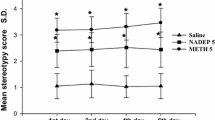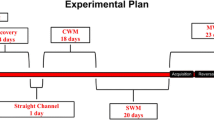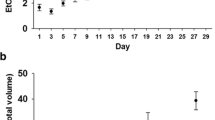Abstract
A variety of drug treatment regimens have been proposed to model the dysphoric state observed during methamphetamine (METH) withdrawal in rats, but little has been established in experiments using mice. In male ICR mice, a fixed-dose injection regimen of METH (1.0 or 2.5 mg/kg, i.p., twice daily for 10 consecutive days) induced a significant decrease in the time spent in open arms in an elevated plus maze after 5 days of drug abstinence. Under an escalating-dose injection regimen (0.2–2.0 mg/kg, i.p., 3 times daily for 4 days, total: 15 mg/kg/animal) or continuous subcutaneous administration with osmotic mini-pumps (15 or 76 mg/kg of METH for 2 weeks), no significant behavioral change was observed after 5 days of drug abstinence, compared with control animals. Reduced gains in body weight were observed during repeated treatment with METH in the fixed-dose injection and mini-pump treatment regimens, but not the escalating-dose injection regimen. HPLC analysis revealed significant decreases in the level of cerebral 3-methoxy-4-hydroxyphenylglycol, a norepinephrine metabolite, and norepinephrine turnover, which may be attributed to the expression of anxiety-related behavior in the elevated plus maze. These observations suggest that the mice treated with a fixed-dose of METH may model the anxiety-related behavior observed in the dysphoric state induced by METH withdrawal in humans.




Similar content being viewed by others
References
Lago JA, Kosten TR (1994) Stimulant withdrawal. Addiction 89:1477–1481
Koob GF, Le Moal M (1997) Drug abuse: hedonic homeostatic dysregulation. Science 278:52–58
Blier P, de Montigny C (1994) Current advances and trends in the treatment of depression. Trends Pharmacol Sci 15:220–226
Booij L, Van der Does AJW, Riedel WJ (2003) Monoamine depletion in psychiatric and healthy population: review. Mol Psychiatry 8:951–973
Stahl SM, Grady MM, Moret C, Briley M (2005) SNRIs: their pharmacology, clinical efficacy, and tolerability in comparison with other classes of antidepressants. CNS Spectrum 10:732–747
McGregor C, Srisurapanont M, Jittiwutikarn J, Laobhripatr S, Wongtan T, White JM (2005) The nature, time course and severity of methamphetamine withdrawal. Addiction 100:1320–1329
Kalechstein AD, Newton TF, Longshore D, Anglin MD, van Gorp WG, Gawin FH (2000) Psychiatric comorbidity of methamphetamine dependence in a forensic sample. J Neuropsychiatry Clin Neurosci 12:480–484
Kantak KM (2003) Vaccines against drugs of abuse: a viable treatment option? Drugs 63:341–352
Dopheide JA (2006) Recognizing and treating depression in children and adolescents. Am J Health Syst Pharm 63:233–243
Kokkinidis L, Zacharko RM, Anisman H (1986) Amphetamine withdrawal: a behavioral evaluation. Life Sci 38:1617–1623
Murphy CA, Fend M, Russig H, Feldon J (2001) Latent inhibition, but not prepulse inhibition, is reduced during withdrawal from an escalating dosage schedule of amphetamine. Behav Neurosci 6:1247–1256
Russig H, Pezze M-A, Nanz-Bahr NI, Pryce CR, Feldon J, Murphy CA (2003) Amphetamine withdrawal does not produce a depressive-like state in rats as measured by three behavioral tests. Behav Pharmacol 14:1–18
Kitanaka J, Kitanaka N, Takemura M (2008) Neurochemical consequences of dysphoric state during amphetamine withdrawal: a review. Neurochem Res 33:204–219
Post RM (1980) Intermittent versus continuous stimulation: effect of time interval on the development of sensitization. Life Sci 26:1275–1282
Eison MS, Eison AS, Iversen SD (1983) Two routes of continuous amphetamine administration induce different behavioral and neurochemical effects in the rat. Neurosci Lett 39:313–319
Robinson TE, Camp DE (1987) Long-lasting effects of escalating doses of d-amphetamine on brain monoamines, amphetamine-induced stereotyped behavior and spontaneous nocturnal locomotion. Pharmacol Biochem Behav 26:821–827
Lin D, Koob GF, Markou A (2000) Time-dependent alterations in ICSS thresholds associated with repeated amphetamine administrations. Pharmacol Biochem Behav 65:407–417
Cryan JF, Hoyer D, Markou A (2003) Withdrawal from chronic amphetamine induces depressive-like behavioral effects in rodents. Biol Psychiatry 54:49–58
Russig H, Murphy CA, Feldon J (2005) Behavioural consequences of withdrawal from three different administration schedules of amphetamine. Behav Brain Res 165:26–35
Peleg-Raibstein D, Sydekum E, Feldon J (2006) Differential effects on prepulse inhibition of withdrawal from two different repeated administration schedules of amphetamine. Int J Neuropsychopharmacol 9:737–749
Kuczenski R, Segal DS, Cho AK, Melega W (1995) Hippocampus norepinephrine, caudate dopamine and serotonin, and behavioral responses to the stereoisomers of amphetamine and methamphetamine. J Neurosci 15:1308–1317
Segal DS, Kuczenski R (1997) An escalating dose “binge” model of amphetamine psychosis: behavioral and neurochemical characteristics. J Neurosci 17:2551–2566
Kitanaka J, Kitanaka N, Tatsuta T, Morita Y, Takemura M (2007) Blockade of brain histamine metabolism alters methamphetamine-induced expression pattern of stereotypy in mice via histamine H1 receptors. Neuroscience 147:765–777
Kitanaka N, Kitanaka J, Tatsuta T, Watabe K, Morita Y, Takemura M (2006) Methamphetamine reward in mice as assessed by conditioned place preference test with Supermex® sensors: effect of subchronic clorgyline pretreatment. Neurochem Res 31:805–813
Kitanaka N, Kitanaka J, Takemura M (2003) Behavioral sensitization and alteration in monoamine metabolism in mice after single versus repeated methamphetamine administration. Eur J Pharmacol 474:63–70
Schildkraut JJ, Watson R, Draskoczy PR, Hartmann E (1971) Amphetamine withdrawal: depression and M.H.P.G. secretion. Lancet 2:485–486
Watson R, Hartmann E, Schildkraut JJ (1972) Amphetamine withdrawal: affective state, sleep patterns, and MHPG excretion. Am J Psychiatry 129:263–269
Hoffman EJ, Mathew SJ (2008) Anxiety disorders: a comprehensive review of pharmacotherapies. Mt Sinai J Med 75:248–262
Short PH, Shuster L (1976) Changes in brain norepinephrine associated with sensitization to d-amphetamine. Psychopharmacology (Berl) 48:59–67
Maas JW, Landis DH (1968) In vivo studies of the metabolism of norepinephrine in the central nervous system. J Pharmacol Exp Ther 163:147–162
Schanberg SM, Schildkraut JJ, Breese GR, Kopin IJ (1968) Metabolism of normetanephrine-H3 in rat brain: identification of conjugated 3-methoxy-4-hydrophenylglycol as the major metabolite. Biochem Pharmacol 17:247–254
Kitanaka N, Kitanaka J, Takemura M (2005) Repeated clorgyline treatment inhibits methamphetamine-induced behavioral sensitization in mice. Neurochem Res 30:445–451
Bueno CH, Zangrossi H Jr, Viana Mde B (2007) GABA/benzodiazepine receptors in the ventromedial hypothalamic nucleus regulate both anxiety and panic-related defensive responses in the elevated T-maze. Brain Res Bull 74:134–141
Schallek W, Schlosser W (1979) Neuropharmacology of sedatives and anxiolytics. Mod Probl Pharmacopsychiatry 14:157–173
Smith RJ, Aston-Jones G (2008) Noradrenergic transmission in the extended amygdala: role in increased drug-seeking and relapse during protracted drug abstinence. Brain Struct Funct 213:43–61
Acknowledgments
The authors are grateful to Ms. A. Yoshioka of the Department of Pharmacology, Hyogo College of Medicine, for preparing the animal study proposal, to Mr. T. Nakajima of Joint-Use Research Facilities, Hyogo College of Medicine, for constructing the elevated plus maze, and to Mrs. H. Takahashi and H. Kubo of Muromachi Kikai Co., Ltd. for their technical advice on the tail suspension test. This research was supported, in part, by a Grant-in-Aid for Young Scientists (B) from the Ministry of Education, Culture, Sports, Science, and Technology of Japan (No. 21790254 to N.K.) and a Grant-in-Aid for Researchers from Hyogo College of Medicine (2009 to J.K.).
Author information
Authors and Affiliations
Corresponding author
Rights and permissions
About this article
Cite this article
Kitanaka, N., Kitanaka, J., Tatsuta, T. et al. Withdrawal from Fixed-Dose Injection of Methamphetamine Decreases Cerebral Levels of 3-Methoxy-4-hydroxyphenylglycol and Induces the Expression of Anxiety-Related Behavior in Mice. Neurochem Res 35, 749–760 (2010). https://doi.org/10.1007/s11064-010-0132-4
Accepted:
Published:
Issue Date:
DOI: https://doi.org/10.1007/s11064-010-0132-4




